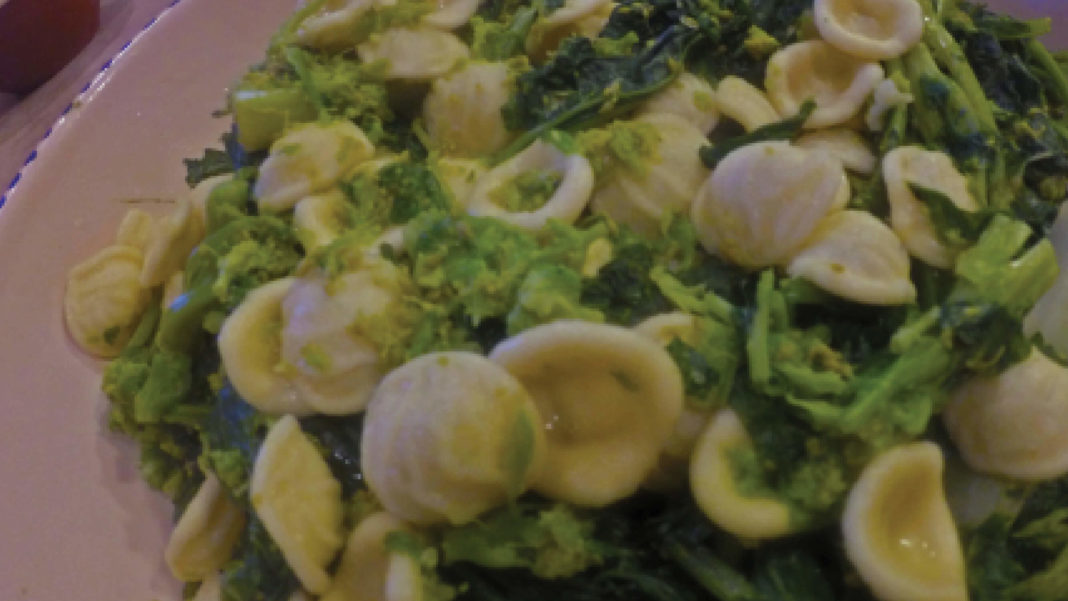Podcast: Play in new window | Download
Orecchiette with broccoli rabe is one of the signature dishes in Puglia. In this podcast, Paul and I are joined by Anna Vocino as we talk all about this amazing dish.
Topics we cover:
- How long it’s been since Anna’s last visit in person
- How Paul and I are getting married now that gay marriage is recognized in Italy
- The different versions and spelling so broccoli rabe
- For the record, it’s spelled rabe, or raab, and sometimes called rapini.
- In Puglia, it’s called cime di rape (roughly translate to turnip tops)
- We discuss more of the broccoli rabe characteristics, which I cover more in detail below
- In northern Italy, they will throw away the little “heads” of the broccoli rabe and eat only the leaves
- In some places in southern Italy, they will throw away the leaves and each only the “heads”
- We eat everything
- What exactly caper berries are and where they come from
- Essentially, a caper is a small bud on a caper bush. You pick these buds before they flower and preserve them to have capers
- If you don’t pick the capers, they turn into beautiful flowers and the pistol becomes caper berries
- We pickle them to use in our martinis
- How you will never go hungry in southern Italy as you can find all kinds of food growing wild
- Paul’s memory of all the older Italians going out into the fields and picking wild greens, like wild baby fennel and chicory
- How broccoli rabe is one of the most nutrient dense foods (again, more info below)
- If you are going to pick wild greens, you need to look for uncontaminated areas (i.e. free of herbicides)
- Orecchiette pasta
- Called this because they look like little ears which is a direct translation of the name
- It has a different name in the location dialect
- The difficultly it making the pasta
- But when you make a mistake in making an orecchiette, it becomes cavatelli
- Paul’s technique for making orecchiette with broccoli rabe (video below):
- Take your clean broccoli rabe and put into boiling water
- After you cook the broccoli rabe for about 10 minutes, you then add the orecchiette into the same pot
- When the pasta is cooked, you take it all out of the water and top with a mixture of garlic, anchovies and extra virgin olive oil
- How oreccheitte with sausage and broccoli rabe is not really very traditional in southern Italy mainly because meat was not always available
- Steven’s technique for making orecchiette with broccoli rabe, which gets rid of the bitterness of the broccolli rabe:
- Boil the broccolli rabe as in Paul’s version, but remove from the water after five minutes (your are blanching them)
- Then add them to another pot with the extra virgin olive oil, chopped garlic and anchovies. Sauté that the create your sauce.
- Cook the pasta separately and combine
- How most Americans are not used to cooking with anchovies
- How ancient Romans used garum (fermented fish guts) to season their food
- The cookbook we mention on the show is Cooking Apicius
- A rather explicit story of Marlon Brandon
- Portnoy’s Complaint is the other explicit book Paul mentions on the podcast
- Anna’s recipe for the broccolli rabe:
- Ann shaves the bottom the stems to make them more tender
- Paul says the easier way to to this is to cut a cross into the stems to make sure they open up and cook
- After washing off the broccoli rabe, she throws it into a pot with extra virgin olive oil and garlic (not rinsing the broccoli too much as you want the water — cover it, which steams the broccoli and after the water has evaporated the garlic caramelizes and helps take the edge of the brocolli rabe
- How you appreciate bitterness the older you get
- For example, Paul never used to like cipaduzze, or wild hyacinth bulbs, but now loves them
- They are very, very bitter and grow very deep in the ground
- You usually boil them, then squish them, and drizzle with extra virgin olive oil and salt
- How they grow the cipaduzze now
A video of the recipe
Orecchiette
 It’s a traditional Puglia pasta whose name translates to “little ears” though the shape, as you can see, is more like little hats.
It’s a traditional Puglia pasta whose name translates to “little ears” though the shape, as you can see, is more like little hats.
Not only it is good with broccoli rabe, but the shape is great with ragu and hearty meat sauces to help scoop up the sauce.
Broccoli rabe
Also spelled raab, and sometimes called rapini or broccoletti. In Puglia, it’s called cime di rape.
It is a cool season crop, so you find it in late fall, winter and maybe early spring. In the states you can probably find it all year round, but really, the flavor is best during winter.
It features broccoli-like tiny flowerheads that look like tiny broccoli heads, but don’t get as big. All parts are edible, including the stems, leaves and flowheads.
It can have a very bitter, spicy and peppery flavor. But it does mellow out once cooked, and if blanched can almost be eliminated.
Boccoli rabe is also one of the most nutrient-dense foods on the planet. 3.5 ounces provides half your daily requirement of vitamins A and C. It’s also a good source of folate, potassium, fiber, and calcium. Full of Phyto-nutrients and antioxidants, which do all the good thins antioxidants do, like protect you from cancer, lessen inflammation, and more.
Anna’s site again: www.annavocino.com
And we talk with her in other episodes: 038: Is there Italian food without pasta? and 037: Eating gluten-free in Italy with Anna Vocino
















